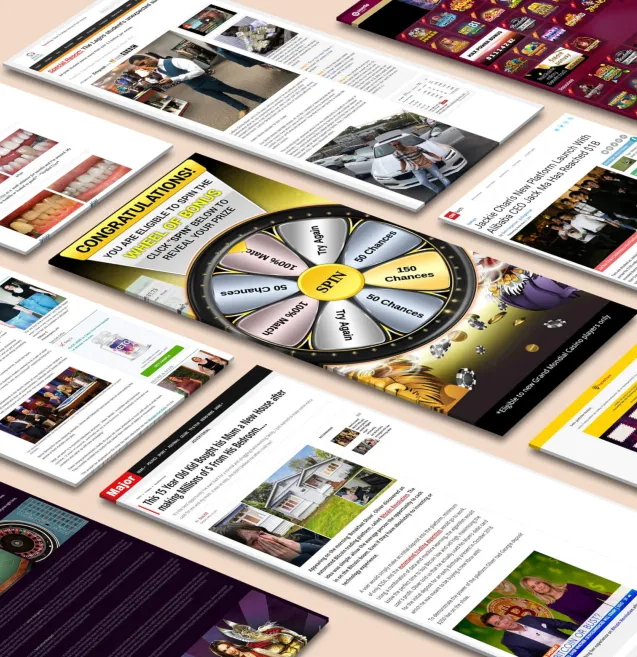
Our spy tools monitor millions of popup and pop-under from over 90+ countries and thousands of publishers.
Get StartedPopup ads - those small windows that appear while browsing - have become a standard feature of the digital landscape. These interactive elements spring up during your online journey, presenting offers, newsletters, or important announcements right when you least expect them. It's intriguing to note how popup ads often appear in correlation with our thoughts or interests.
The psychology behind popup ads reveals fascinating insights into human behavior and decision-making processes. Understanding why users click, engage, or dismiss these ads can make the difference between a successful marketing campaign and a frustrated audience.
Key aspects of popup effectiveness include:
Your response to popup ads might range from mild interest to immediate dismissal. This psychological dance between marketers and users creates a complex relationship that shapes modern digital marketing strategies.
This article explores the psychological mechanisms that make popup ads work, examines scenarios where they fall short, and provides actionable insights for creating effective popup strategies that respect user experience while driving results.
The human brain processes popup ads differently from standard website content, triggering specific psychological responses that marketers can leverage for increased engagement. Research in consumer behavior reveals that popup ads tap into fundamental psychological principles that influence decision-making.
The fear of missing out (FOMO) creates a powerful psychological trigger in popup ads. When users see time-sensitive offers or limited-quantity deals, their brain activates the scarcity response - a primitive instinct that drives immediate action.
Common urgency tactics that trigger FOMO include:
These tactics work by creating a sense of scarcity and exclusivity. A study by ConversionXL found that adding urgency elements to popup ads increased conversion rates by up to 147%.
Effective Examples of Urgency in Action:
Risk Factors to Consider:
The psychology of urgency works best when combined with genuine value propositions. Users respond positively to real limited-time offers backed by authentic scarcity. A Baymard Institute study revealed that 89% of users appreciate urgency messaging when it reflects actual limitations rather than artificial constraints.
The timing of urgency-based popups plays a crucial role in their effectiveness. Data shows that displaying popups after users spend 30-60 seconds on a page yields higher conversion rates compared to immediate triggers. This allows visitors to engage with your content before presenting time-sensitive offers.
Pattern interruption is a powerful psychological trigger that makes popup ads effective. Your brain naturally creates patterns while browsing websites - scanning headlines, scrolling through content, clicking links. When a popup appears, it breaks this automated behavior, forcing your attention to shift.
Research by Nielsen Norman Group shows that users develop "banner blindness" to static website elements, but popup ads bypass this phenomenon through their dynamic nature. The sudden appearance creates a micro-moment of surprise that captures attention, even if briefly.
Effective Pattern Interruption Techniques:
A case study by Sumo revealed that pattern-interrupting popups achieved a 9.28% conversion rate - significantly higher than traditional static calls-to-action. Digital Marketer implemented pattern interruption through a two-step popup sequence, increasing their conversion rate by 60%.
Key Success Factors:
The effectiveness of pattern interruption lies in its ability to momentarily break the user's autopilot mode, creating a window of opportunity for meaningful engagement. Advanced tracking tools now allow marketers to identify optimal moments for these interruptions, maximizing their impact while minimizing disruption.
Decision fatigue is a common issue for online users who are faced with numerous options on websites and digital platforms. Research indicates that when people are confronted with too many choices, they often end up not making any decision at all - a phenomenon known as the paradox of choice.
Popup ads are effective tools for simplifying decisions in this complicated digital world. By offering users a clear and straightforward option, these ads cut through the confusion created by multiple competing calls-to-action on a webpage.
Here are some common techniques used in popups to simplify decisions:
A study conducted by Marketing Sherpa found that popups with single, focused offers had a 39% higher conversion rate compared to those that presented multiple options.
The effectiveness of this approach can be attributed to its ability to reduce cognitive load. When users come across a simplified choice in a popup, their mental energy is directed towards making a yes/no decision instead of having to compare various factors.
Here are some successful examples of popup ads that have utilized this simplification technique:
This method of simplifying decision-making has proven to be especially effective during busy shopping seasons when users experience increased decision fatigue from browsing multiple websites and comparing numerous products.
Color choices in popup ads play a crucial role in influencing user behavior and emotional responses. Research shows that different colors trigger specific psychological reactions, directly impacting conversion rates and user engagement.
Key Color Associations in Popup Design:
Strategic color combinations can amplify your popup's effectiveness. A study by QuickSprout revealed that red CTA buttons increased conversion rates by 21% compared to green buttons.
Practical Color Applications:
The psychological impact of colors varies across cultures and demographics. A/B testing reveals that while red might work well for flash sales, blue performs better for newsletter signups or data collection forms.
Color Psychology Tips:
Personalized popup ads create meaningful connections with users by delivering tailored content based on their behavior, preferences, and demographics. Research shows personalized popups achieve 28% higher conversion rates compared to generic ones.
Brands implementing personalized popups report increased customer lifetime value and reduced bounce rates. The key to successful website personalization lies in balancing relevance with privacy concerns—users appreciate tailored content but remain cautious about data collection.
The effectiveness of popup ads isn't guaranteed. Research shows that 73% of users report negative experiences with popup advertisements, highlighting a significant challenge for marketers.
Digital consumers face an average of 4,000 to 10,000 ads daily, leading to a phenomenon known as "popup fatigue." This psychological state occurs when users become desensitized or resistant to popup messages due to:
Real-world examples of intrusive popup experiences that trigger negative user responses include:
The psychological impact of these intrusive experiences creates lasting negative associations:
Studies by the Nielsen Norman Group reveal that 95% of users have negative or neutral feelings toward popup advertisements. This resistance manifests in various behaviors:
These negative responses often translate into measurable business impacts:
Timing plays a crucial role in popup ad effectiveness. Research shows that displaying popups within the first 5 seconds of a user's visit results in significantly lower conversion rates - often below 1%.
The relevance of popup content to the user's current context directly impacts its success rate. A popup promoting winter coats to someone browsing summer dresses creates cognitive dissonance and reduces trust.
Data from marketing studies reveals that poorly timed popups can increase bounce rates by up to 50%. Users exposed to irrelevant popups are 3x more likely to leave a website without taking any action.
The combination of proper timing and contextual relevance creates a foundation for successful popup implementation. A/B testing different timing triggers helps identify optimal moments for specific audience segments.
Poorly executed popup ads can create a ripple effect across your entire website's user experience. Research by Nielsen Norman Group reveals that 73% of users immediately leave websites with intrusive popups, leading to increased bounce rates and decreased engagement.
The impact of popup ads on UX manifests in several critical ways:
A study by Sumo analyzed 2 billion popups and found striking differences in conversion rates:
The key performance indicators affected by popup implementation include:
Data from CXL Institute shows that websites using contextually relevant, well-timed popups experience a 40% lower bounce rate compared to those with aggressive popup strategies. This demonstrates how thoughtful popup implementation can maintain positive user experiences while achieving marketing objectives.
Creating high-converting popup ads requires a strategic blend of design principles and psychological understanding. A well-crafted popup strategy can transform casual visitors into engaged subscribers and customers.
The visual appeal of your popup directly impacts its performance. Here are essential design elements that drive conversions:
Your popup design should reflect your brand identity while maintaining simplicity. Research shows that popups with 3-4 form fields achieve optimal conversion rates, balancing data collection with user convenience.
Testing and Optimization Process
Successful popup designs often incorporate social proof elements:
A data-driven approach to popup design helps identify what resonates with your specific audience. Track metrics like:
Remember to maintain brand consistency across your popup designs while experimenting with different elements to find the perfect combination for your audience.
Smart popup timing relies on specific user behaviors that indicate engagement and readiness to convert. Here are the key behavioral triggers that maximize popup effectiveness:
This method tracks the movement of the user's mouse towards the browser's close button, indicating that they are about to leave the page. In response, a last-chance offer is triggered just before the visitor exits. Studies have shown that this approach results in conversion rates that are 5-10% higher compared to time-based triggers.
By monitoring how far down the page a user scrolls, popups can be activated when users reach 50-70% of the page content. This behavior suggests a genuine interest in your content, making it an opportune moment for presenting content upgrades or related offers.
Triggers can also be set based on how long a user stays on a particular page. For instance, if someone spends 30-60 seconds on a page, it may indicate their interest in simple offers, while those who linger for over 2 minutes might be more receptive to complex promotions. Custom timing can also be established based on the average session length of your website visitors.
Monitoring specific button or link interactions can provide valuable insights into user intent. For example, if a user frequently clicks on product category views or visits multiple pages within your site, you can tailor popups to align with their interests and preferences.
Identifying periods of user disengagement can help re-engage visitors who may have lost interest or become distracted. By detecting 45-60 seconds of idle time, you can present relevant content or offers to capture their attention once again.
Different devices have unique user behaviors that can be leveraged for effective popup targeting. For instance, mobile users may exhibit specific touch patterns and scroll velocity, while desktop users may demonstrate mouse movement and hover actions. Tablet users may also display orientation changes and gesture tracking behaviors that can influence popup timing.
These behavioral triggers work best when combined with analytics data to identify optimal timing patterns for your specific audience segments.
Creating effective popup ads requires a delicate balance between delivering value and maintaining positive user experience. A well-crafted value proposition acts as the cornerstone of successful popup advertising strategy.
The most successful popups follow the "fair exchange principle" - offering something valuable in return for user attention. Examples include:
A/B testing different value propositions helps identify what resonates best with your audience while maintaining positive UX metrics. Track bounce rates, time on page, and user feedback to fine-tune your popup strategy.
Remember: The best popup experiences feel like a natural extension of the user journey rather than an interruption. Focus on creating genuine value exchanges that enhance rather than detract from the browsing experience.
Popup advertising is constantly changing due to new technology and shifting user expectations. Smart marketers understand that successful popup strategies need to adapt to these changes:
The basic principles behind why popups work - urgency, breaking patterns, and making decisions easier - still hold true. But now, we're finding more complex ways to apply these principles.
The future belongs to marketers who can find the right balance between grabbing attention and respecting the user's experience. Successful popup strategies will focus on delivering value through:
As we move away from marketing that interrupts people towards marketing that invites them in, we can expect popup advertising to evolve as well. Marketers can use Anstrex's secrets of pop ads to create scalable pop advertising strategies that deliver measurable results.
However, it's crucial to remember that successful popup advertising isn't just about the technical side of things. It's also important to understand the cultural differences of your target audience. This becomes especially relevant when thinking about navigating cultural differences in ads, which can have a significant impact on how effective native advertising strategies are.
By building genuine connections with users while also respecting their online experience, marketers can find the right balance that leads to both engagement and conversion.
Receive top converting landing pages in your inbox every week from us.
Guide
This blog dives into the power of cross-screen pop advertising and how it helps brands stay visible across multiple devices. It discusses key strategies for creating cohesive campaigns that engage users whether they’re on desktop, mobile, or tablet. Readers will discover optimization techniques, targeting tips, and creative best practices to improve performance. Ideal for advertisers looking to boost reach and conversions through a unified pop ad approach.
Elena Morales
7 minNov 16, 2025
How-To
Ethical pop advertising represents a fundamental shift in how digital marketers approach user engagement. Rather than bombarding visitors with intrusive interruptions, this approach prioritizes respect, honesty, and genuine value exchange. The digital marketing landscape has reached a critical juncture where user trust in pop ads directly impacts campaign success and brand longevity.
Rachel Thompson
7 minNov 10, 2025
Tips & Tricks
Conversion rate optimization (CRO) for pop traffic isn't the same as optimizing for other traffic sources. Pop ads bring unique challenges—visitors arrive unexpectedly, often with lower intent, and you have mere seconds to convince them your offer is worth their attention. The difference between a 2% conversion rate and a 12% conversion rate can transform your entire campaign profitability.
Marcus Chen
7 minNov 4, 2025




